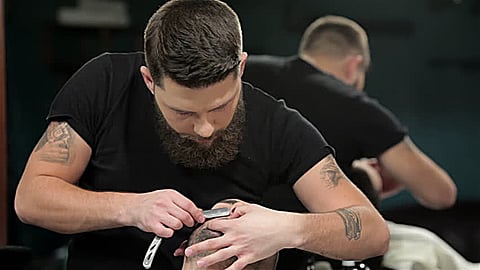YouTubers help male grooming finally step out of the shadows
Videos featuring male beauty products and grooming tips are gaining traction and challenging traditional gender notions

His video, I’m Testing a Blackhead Vacuum, has more than 200,000 views. The one entitled, Baldness: My Hair Transplant has been seen at least 440,000 times. But his best-seller remains How to Have a Beautiful, Well-Trimmed Beard, with more than 800,000 views. Since he created his YouTube channel, The Winslegue Tutorials, two and a half years ago, Westley, 36, has become the most popular French-speaking male beauty YouTuber, with more than 100,000 subscribers.
His credo? The same as that of his female counterparts: Test and comment on any and all men’s beauty products, increasingly in serious competition with those of women. “In the past, you used to have to take stuff from your girlfriend’s toiletry case. Now we have our own, well-stocked shelf: balms and oils for the beard, hydrating creams, scrubs, masks, epilating strips for the eyebrows, conditioner, concealer, hair-styling powders,” Westley says.
The star YouTuber notes that the beauty industry has understood that the Instagram generation is very attentive to image, and that includes men, which is a specific market unto itself. The value of this market in Switzerland alone is estimated at 19 million Swiss francs (about $19.3 million, Dh70.8 million), as men no longer hesitate to display themselves coated in a scrubbing mask or to detail their “beauty routine” online.
From Alpha M, an American YouTuber who has seduced about 3 million subscribers, to the two French brothers behind the channel So Style, through the Danish channel Slikhaar, guys spend hours upon hours on the art of having whiter teeth, hiding a pimple or lighting up their eyes with a touch gel in the eyebrows. “There is a real break between those over and under 40. The younger generation has a more open approach to masculinity,” says Marc Briant-Terlet, co-founder of the Horace beauty product brand.
“For a long time, brands sold men products associated with virility,” Briant-Terlet adds. “A cream was expected to tug on the skin and shower gels smelled like peppermint. But our clients appreciate more subtle products. The pitch is also less patronising. We no longer tell men that by taking care of themselves they’ll become great athletes or meet a stunning girl, but that taking care of oneself is part of nurturing your well-being.”
On its site, Horace also offers a magazine section to respond to any sort of narcissistic question: “Should you use chapstick?” or “How to care for your eyebrows.” “Men take better care of themselves, but it still remains a difficult topic to talk about,” says Briant-Terlet. “Few fathers explain to their sons how to exfoliate.”
Westley has also created a closed Facebook group for guys to chat among themselves, without taboos. “I’m trying to free male speech,” he says. “The most frequently asked question is about the dissimulation of white hairs in a beard. But subscribers also ask how to shave their private parts without hurting themselves.”
Because male pilosity is also at the centre of a new aesthetic, accompanied by a booming market, from Braun’s multi-hair removal kit for men to Wilkinson’s shaver for private parts.
“Until now, a man was content with the beauty capital he received at birth. Now, he is trapped by the same need as women to improve that capital,” observes the philosopher Bernard Andrieu, author of Rester Beau, or “Staying Beautiful.” “He’s no longer satisfied with external hygiene, razors or deodorant, but now adopts new sensory habits, investing in that which is more than skin deep, this contemporary symbol of professional, relational, sexual vitality. All those self-improvement techniques formerly reserved for women are now masculinised.”
Ironically, men’s claim to coquetry comes at a time when women are rejecting the aesthetic diktats of society, particularly through the body positive movement. So much so that some boycott razors even on catwalks of haute couture shows: “I have more and more male students with smooth torsos or calves,” Andrieu remarks. “It’s a real market inversion: Women have started criticising the norm, while men are imposing new standards. But they have always lagged behind women.”
Brands are now making men their core target, as men today are less reluctant than women to spend hours in the bathroom. In 2015, Google already announced in its annual report, Beauty Trends, that men were spending more time consulting hairdressing websites than women. Do these changes mean that men will begin lighting their faces up even more with makeup? Big e-shopping platforms like Asos are offering a range of eyeliners, foundations and blushes for men, while males have become the muses of makeup brands, like Manny Gutierrez (aka Manny Mua), Maybelline’s ambassador. Emmanuel Macron, too, recently paid his makeup artist 26,000 euros for three months of work.
Alas, male makeup is emerging just as many feminists denounce its use, and singer Alicia Keys has announced that she hasn’t worn makeup at all for over a year. Or the English writer Zadie Smith, who has forbidden her daughter to spend more than 15 minutes daily in front of the mirror: “I explained it to her in these terms: You are wasting time, your brother is not going to waste any time doing this. Every day of his life he will put a shirt on, he’s out the door,” Smith said. The way the industry is going now, soon it may be the other way around.
— Worldcrunch/New York Times News Service
Julie Rambal is a columnist who writes on style and fashion.
Sign up for the Daily Briefing
Get the latest news and updates straight to your inbox



